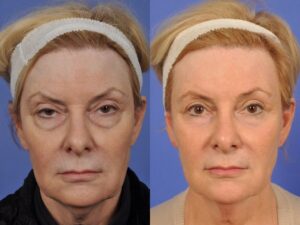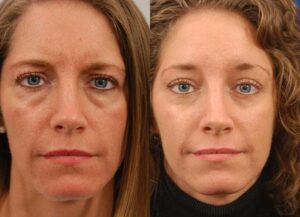Blepharoplasty
Blepharoplasty is the procedure to reshape and tighten the eyelids. This procedure can reduce the wrinkles and the “bags” around the eye, and can give a younger look.
Age causes increased wrinkling and creases around the eyes. The orbital septum weakens and fat herniates through causing the characteristic “eye bagging”. The ageing process can also cause drooping of the eyelids, and folds of skin to gather in the upper eyelids.
Sometimes, a sagging forehead and eyebrow can make the upper eyelid look like it is sagging. Your surgeon may recommend an eyebrow lift instead.
Surgery
The blepharoplasty can be performed on the upper eyelid, the lower eyelid, or both. It is usually carried out under local anesthetic, but some patients find it more comfortable if they are asleep and they request general anesthetic
Upper blepharoplasty
Your surgeon removes an ellipse of skin around a crease on your upper eyelid. He will then remove any excess fat and suture the eyelid skin back together.
Lower blepharoplasty
The treatment philosophy for lower eyelid surgery has changed from an operation that used to remove much of the herniating fat, to a procedure that aims to tighten the orbital septum (and that way to correct the sagging appearance of the lower eyelid) and removal as little fat as possible. Excess skin is removed and the wound is sutured back together.
Possible complications
Like any other surgical procedure, blepharoplasty has potential risks. Your OMFS surgeon will discuss these risks prior to your surgery, so that you can make an informed decision, weighing the potential benefits of having the procedure versus the risks. The most common complications are:
- Scars
- Bleeding: Very rarely, this can be significant enough to cause retrobulbar hemorrhage (link to my chapter)
- Infection
- Swelling and bruising
- Ectropion: Sometimes the lower eyelid is pulled downwards and is pushed away from they eye. This can happen if too too much skin is removed; your eyelid becomes tight and you cannot close it properly. It usually settles with time
After the procedure:
A blepharoplasty takes around 2 hours.
- You will be given an antibiotic ointment to keep the wound clean.
- You will be able to go home the same day
- You will be prescribed painkillers
- You will be given eyedrops to ease the feeling of grittiness
- You will have the sutures removed 5 days after the procedure
- Bruising around the eyelids is common and can last for 2 weeks
- Avoid straining or weight lifting for few weeks
The initial results will be obvious within 6 weeks, but the healing process and the final outcome might take up to 6 months to settle. Your surgeon will see you for follow up and take post-surgical photographs for your record.



